
Accelerated Graphics Port (AGP) is an expansion bus standard, designed for attaching a video card to a computer system to assist in the acceleration of 3D computer graphics. It was originally designed as a successor to PCI-type connections for video cards. Since 2004, AGP has been progressively phased out in favor of PCI Express (PCIe); by mid-2008, PCI Express cards dominated the market and only a few AGP models were available, with GPU manufacturers and add-in board partners eventually dropping support for the interface in favor of PCI Express.
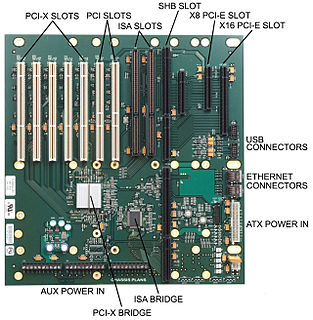
A backplane is a group of electrical connectors in parallel with each other, so that each pin of each connector is linked to the same relative pin of all the other connectors, forming a computer bus. It is used as a backbone to connect several printed circuit boards together to make up a complete computer system. Backplanes commonly use a printed circuit board, but wire-wrapped backplanes have also been used in minicomputers and high-reliability applications.

A punched card is a piece of stiff paper that holds digital data represented by the presence or absence of holes in predefined positions. Punched cards were once common in data processing applications or to directly control automated machinery.
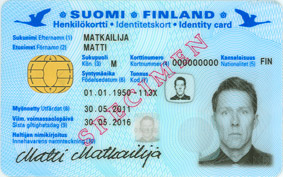
A smart card, chip card, or integrated circuit card is a physical electronic authorization device, used to control access to a resource. It is typically a plastic credit card-sized card with an embedded integrated circuit (IC) chip. Many smart cards include a pattern of metal contacts to electrically connect to the internal chip. Others are contactless, and some are both. Smart cards can provide personal identification, authentication, data storage, and application processing. Applications include identification, financial, mobile phones (SIM), public transit, computer security, schools, and healthcare. Smart cards may provide strong security authentication for single sign-on (SSO) within organizations. Numerous nations have deployed smart cards throughout their populations.

In the United States, bingo is a game of chance in which each player matches numbers printed in different arrangements on cards with the numbers the game host (caller) draws at random, marking the selected numbers with tiles. When a player finds the selected numbers are arranged on their card in a row, they call out "Bingo!" to alert all participants to a winning card, which prompts the game host to examine the card for verification of the win. Players compete against one another to be the first to have a winning arrangement for the prize or jackpot. After a winner is declared, the players clear their number cards of the tiles and the game host begins a new round of play.

A yearbook, also known as an annual, is a type of a book published annually. One use is to record, highlight, and commemorate the past year of a school. The term also refers to a book of statistics or facts published annually. A yearbook often has an overarching theme that is present throughout the entire book.

Business cards are cards bearing business information about a company or individual. They are shared during formal introductions as a convenience and a memory aid. A business card typically includes the giver's name, company or business affiliation and contact information such as street addresses, telephone number(s), fax number, e-mail addresses and website. Before the advent of electronic communication business cards might also include telex details. Now they may include social media addresses such as Facebook, LinkedIn and Twitter. Traditionally, many cards were simple black text on white stock, and the distinctive look and feel of cards printed from an engraved plate was a desirable sign of professionalism. In the late 20th century, technological advances drove changes in style, and today a professional business card will often include one or more aspects of striking visual design.

Contacts is a computerized address book included with the Apple operating systems iOS, iPadOS and macOS, previously Mac OS X and OS X. It includes various cloud synchronization capabilities and integrates with other Apple applications and features, including iMessage, FaceTime and the iCloud service.
An identity document is any document that may be used to prove a person's identity. If issued in a small, standard credit card size form, it is usually called an identity card, or passport card. Some countries issue formal identity documents, as national identification cards which may be compulsory or non-compulsory, while others may require identity verification using regional identification or informal documents. When the identity document incorporates a person's photograph, it may be called photo ID.

A visiting card, also known as a calling card, is a small card used for social purposes. Before the 18th century, visitors making social calls left handwritten notes at the home of friends who were not at home. By the 1760s, the upper classes in France and Italy were leaving printed visiting cards decorated with images on one side and a blank space for hand-writing a note on the other. The style quickly spread across Europe and to the United States. As printing technology improved, elaborate color designs became increasingly popular. However, by the late 1800s, simpler styles became more common.

An address book or a name and address book is a book or a database used for storing entries called contacts. Each contact entry usually consists of a few standard fields. Most such systems store the details in alphabetical order of people's names, although in paper-based address books entries can easily end up out of order as the owner inserts details of more individuals or as people move. Many address books use small ring binders that allow adding, removing and shuffling of pages to make room.

Classroom Management is a term teachers use to describe the process of ensuring that classroom lessons run smoothly without disruptive behavior from students compromising the delivery of instruction. The term also implies the prevention of disruptive behavior preemptively, as well as effectively responding to it after it happens.
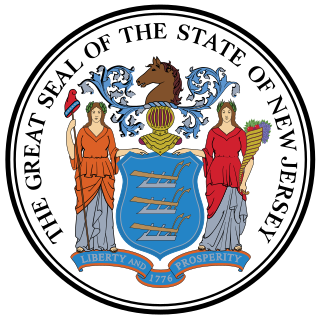
The New Jersey School Report Card is an annual report produced each year by the New Jersey Department of Education for all school districts and schools in the U.S. state of New Jersey. The current School Report Card presents thirty-five fields of information for each school in the following categories: school environment, students, student performance indicators, staff, and district finances; however, initially the cards provided far less information.
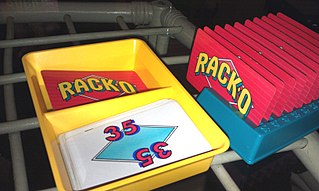
Rack-O is a Milton Bradley sequential-matching card game with the objective of obtaining 10 numbers, in numerical order, in one's hand. Score may be kept on a separate piece of paper, based upon either a custom system or the system provided in the rule book. Rack-O allows between 2-4 players, and is recommended for players age 8 and up. Rack-O was released in 1956 and is currently being produced by Winning Moves Games USA.
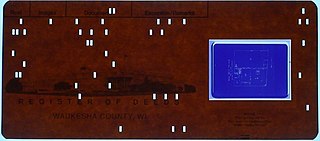
An aperture card is a type of punched card with a cut-out window into which a chip of microfilm is mounted. Such a card is used for archiving or for making multiple inexpensive copies of a document for ease of distribution. The card is typically punched with machine-readable metadata associated with the microfilm image, and printed across the top of the card for visual identification; it may also be punched by hand in the form of an edge-notched card. The microfilm chip is most commonly 35mm in height, and contains an optically reduced image, usually of some type of reference document, such as an engineering drawing, that is the focus of the archiving process. Machinery exists to automatically store, retrieve, sort, duplicate, create, and digitize cards with a high level of automation.

A report card, or just report in British English, communicates a student's performance academically. In most places, the report card is issued by the school to the student or the student's parents once to four times yearly. A typical report card uses a grading scale to determine the quality of a student's school work. Throughout North America, the grading scale consists of grades scored in classes taken by the student. Report cards are now frequently issued in automated form by computers and may be mailed to parents and students. Traditional school report cards contained a section for teachers to record individual comments about the student's work and behavior. Some automated card systems provide for teachers' including such comments, but others limit the report card to grades only.

The LG Cosmos is a slider mobile phone made by LG Electronics. The phone is available in both a touch screen and non-touch screen model. It became available on Verizon Wireless in Q1 2010, and was replaced by LG Cosmos 2 in July 2011. The phone has 1.3-megapixel camera, VZ Navigator, Voicemail, Media Center, QWERTY keyboard and SMS and MMS messaging.
A card-not-present transaction is a payment card transaction made where the cardholder does not or cannot physically present the card for a merchant's visual examination at the time that an order is given and payment effected. It is most commonly used for payments made over Internet, but also mail-order transactions by mail or fax, or over the telephone.

The Resident Identity Card is an official identity document for personal identification in the People's Republic of China. According to the second chapter, tenth clause of the Resident Identity Card Law, residents are required to apply for resident identity cards from the local Public Security Bureau, sub-bureaus or local executive police stations.
eKool is a school management system used in Estonia covering 90% of the nation's school network connecting all the pupils, parents and teachers involved. It is estimated that this application is used by 28-30% of Estonians in total. The name eKool means eSchool in Estonian.

















